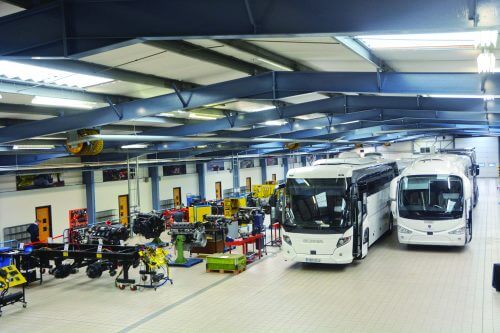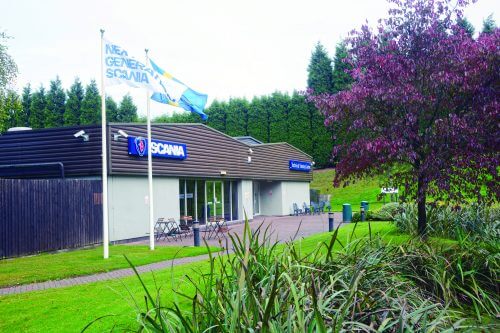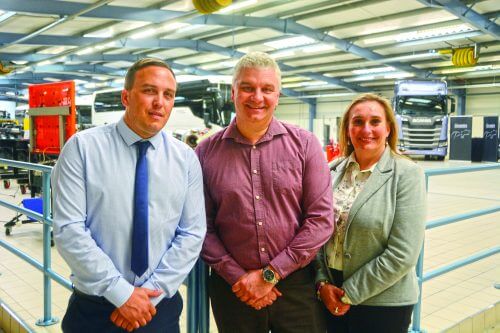
Scania sees training as vital in developing its staff as well as building and maintaining relationships with customers. Its Training Centre near Loughborough plays a key role in what is a multifaceted approach that also harnesses the latest technology to deliver the best all round service as Andy Izatt discovers
Scania (Great Britain) Training Centre near Loughborough might be tucked away in the Leicestershire countryside, but the important part it plays in the Swedish manufacturer’s service delivery nationally shouldn’t be underestimated. It’s an impressively well-equipped facility that’s indicative of a company-wide determination to ensure that staff and customers are properly equipped to get the best from products.
Mark Oliver is now Scania UK Bus & Coach Fleet Sales General Manager, but he spent 12 years at the Loughborough site where he was Technical Services Manager. “I started with Scania in 1994 training apprentices at a college in Coalville,” he recalled. “There were three instructors including me. Scania introduced a new modularised way of training and as the programme grew we moved to what is now the Training Centre in 2000. Up until 2005 it was used purely as a training facility. We used to complete 7,500 man-days of technical training annually for the Scania network including at least 2,000 for truck, bus and coach customers.
“We were primarily training technical people from the dealer network as well as fulfilling our own apprentice programme. That encompassed the body (Scania bodybuilding partners) as well as chassis. What we provided for customers was bespoke. While some training courses were conducted remotely, the advantage of training at Loughborough was it could be more in-depth due to the classroom facilities, a workshop where we could take the product apart and we were able to simulate diagnostic troubleshooting to a greater depth.
“Customer training actually started with the fire brigade in Scotland which wanted to introduce a formulised training structure. There were four levels and what we were providing soon attracted the interest of bus operators because they organised their workshops in a similar way. Our remit was expanding all of the time and a growing number of customers were sending their technicians to Loughborough.”
“It’s a careful balancing act,” pointed out Laurence Medina who is Head of Learning, Development and Process Improvement at Scania (Great Britain). “We want to encourage customers to use our workshops rather than maintain vehicles themselves, but we need to respond to all their requirements. Training customers’ technicians helps engender loyalty adding value to the relationship.”
Said Mark: “There are very few truck customers these days that have their own workshops. They run with R & M (repair and maintenance) contracts and rely on the manufacturers for service and maintenance. It’s the same now with a lot of bus and coach retail customers. They will have new vehicles on R & M for two years and then will run them using their own workshops.
“If they require technical training, the team here will be informed of who is buying what and where, and that will be incorporated into the field assistance that can be provided which extends from familiarisation training through to diagnostics courses. It all depends on what level of support the customer wants from their local Scania dealer.
“I’m involved with fleet operators like Nottingham City Transport, Reading Buses, Stagecoach, FirstGroup, Translink and Lothian. They own their own workshops and in a lot of cases when I tender, they will ask me to include an element of technical training that can be called upon as and when they require it. It’s about complementing what they do with additional training.
“Once we started having customers and their technicians at Loughborough, and they saw what we were capable of doing, they wanted us to train their apprentices as well. We initially resisted that because there wasn’t an accredited bespoke bus and coach programme. It was generic for heavy vehicle, but when that changed we offered one which we still run today. It has been developed in conjunction with operators like Nottingham City Transport and Trent Barton. Lloyd Mason (Engineering Development Manager) from Arriva was particularly helpful.”
“The Training Centre is busy all the time now,” said Laurence. “Particularly so at the moment because Scania has just launched a new truck. We have been training front of house staff from the dealerships, managers and now we’re training technicians on the actual vehicle. We’re also (at the time of writing) just about to have our apprentice graduation and announce the winners of our Apprentice of the Year competition. On top of that there are customers here using the conference facilities. Whether they come with people from Scania or not, they’re always welcome.”
Multifaceted approach
“The Training Centre isn’t the only place we bring customers,” Laurence continued. “There’s the head office in Milton Keynes, Bus and Coach at Worksop and Scania Assistance in Bradford all providing different perspectives on the business. Then there’s the dealer network, which is like having regional head offices. Around 50% of that is owned by Scania (Great Britain).
“Although I’m responsible for Loughborough, I’m based at head office in Milton Keynes. As well as being in charge of technical training, commercial training, leadership and management, and the apprentice programmes, I have another team who are field-based and work on process improvement. They’re training people within the organisation and coaching them to look at their processes and streamline them. We have a continuous improvement methodology for that where the standards are documented. At the moment we’re training people to implement Service Flow, our service process.”
Said Mark: “Because Scania (Great Britain) owns 50% of the network and there are only six independent dealer principals, when we’re looking at putting through new systems or a new training portfolio, decisions can be made together in one room with just seven people and that’s a real strength. We can quickly implement a standard or deliver a consistent response.

“As well as learning and development at Loughborough, there’s the technical department. Scania globally started to go through retail integration in 2004. The truck technical department that was at Milton Keynes and the bus and coach equivalent at Worksop were merged and moved here the following year.
“Anything from an aftersales technical point of view is coordinated and managed by Aaron McGrath (Technical Manager – Aftersales) and his 10 engineers who have direct access to the factory at Södertälje in Sweden. In addition to the technical desk for day-to-day VOR (Vehicle off the Road) issues, there’s Field Quality, measuring performance with vehicles out in the network.
“Having 80-plus technicians here on courses every week giving aftersales feedback to their instructors gives us a unique advantage because technical department staff have direct access to that information. The technical updates that they issue can be incorporated into training courses without delay and the instructors also get a heads up on what’s coming down the line in the future. It underlined the big advantage of everything being based on one site and we very quickly saw the benefit.
“There’s a full range of Scania products here for technicians to work on. Vehicles are on a rolling programme. There are a couple of coaches and a city bus and after a set period of time they will be replaced by newer examples. That means instructors can actually see any changes in products and be able to incorporate that into training. The technical department team can take a close look at what’s altered as well and Aaron’s guys have headsets so they can walk anywhere in the building while talking to a dealer or the factory.”
Enhancing support
“We’re in the process of enhancing our technical support and that will be launched later in the year,” explained Aaron. “My engineers have their own specialties specific to component group areas. For example one engineer might look after engine fuel systems and cooling while another might be responsible for electrics, suspension and steering. While they specialise, what they do apples right across the product portfolio.”
“This is an important point to emphasis because we’re sometimes seen as a truck manufacturer with just a bus and coach element,” said Mark. “We might well sell large volumes of trucks annually, but our strength comes from having that modularity across all our engine and chassis platforms. It’s that combination of volume and design that enables us to afford this facility and make best use of it.”
“Engines alone are a huge market for us,” Aaron continued. “We supply organisations and companies as diverse as the RNLI and Terex. I have three engineers working on industrial marine product, but two of those also cross over into truck and bus. Industrial marine is seasonal so what they’re involved in depends on the time of year. With the modularity that we employ it doesn’t matter if it’s used in a truck or a bus or another application. It’s the same core unit.
“We’ve implemented a lot of new communication technology in the last 18 months. Video conferencing and having an internet phone system all helps us talk to the factory in Sweden and the dealer network. Using our remote diagnostics we can literally type in a truck chassis number, click send and that will ping the vehicle, which will then send us fault codes, any information regarding servicing and anything else we might want to know. What it means is that we can talk live with the vehicle as it drives down the road and see all the operational data from the route that it’s taking.”
“The Scania Communicator has also been installed as standard on retail coaches for a number of years and we’ve just started introducing it for buses as well,” said Mark. “There have been alternatives like GreenRoad that some bus operators have used, but the way the technology is going, it make sense for us to make best use of our system.
“City buses are domicile. While we have a standard vehicle that we supply in line with a tender requirement, there are and have been instances when we have been able to tweak performance to a specific route environment. What we’re doing is working with operators to ensure they get the best out of their Scania vehicles and in the future our remote diagnostics will make the fault diagnosis process quicker and easier.”
Said Laurence: “When a job card is created by a dealer service receptionist, it’s compulsory now to send for remote diagnostic information from the vehicle concerned so that it can all be accesses in good time whether it’s for maintenance or because there has been a problem. By doing that, it’s then possible to tell the customer what’s happening, obtain the necessary authorisations and ensure that the right parts are available prior to work starting thus ensuring downtime is minimised. In the last six months we have really pushed training to make sure this happens.”
“It’s possible to connect to the vehicle communication interface from a dealer anywhere in the country and we can do the same from here, as can the factory in Sweden,” said Aaron. “It’s a really powerful tool. We’re also working at the moment on how we deliver software updates. When the vehicle comes in for a service, for example, the factory in Sweden might release a new software update and we can apply that in a short space of time. We connect it to a laptop, download the software and that’s flashed into the vehicle control units in a process that takes around 15 minutes. Software updates have been around since 2001. When they were first introduced they used to come on a floppy disk from Sweden. With the latest technology we’re now ramping up and seeing the benefits as a result.”
Said Mark: “Scania has actually been using smart technologies on vehicles for over 10 years. What customers don’t necessarily realise is everything that is going on behind the scenes.”
Valued facility

“The value of having a facility like the Training Centre is brought home when we introduce new product like the Next Generation Scania truck,” said Mark. “Compared to previous launches in the 1990s, now we’re so much better equipped because training is in place, technicians are prepared and technical response teams are ready. All of that preparation takes place here.”
Said Laurence: “We work really closely with Scania in Sweden and networks in other countries. As soon as there’s a new chassis or body we immediately send our instructors to the appropriate factory so that they’re properly trained ready to teach the technicians. It makes sense to work with other countries to develop courses together and we can then tweak them according to our specific market requirements.”
“When we launched the first gas buses for Reading and the Caetano double-deckers that Translink purchased, we had people from the training department and technical help desk at the relevant factories to learn about the product,” said Mark. “They all received the same technical information which was cascaded to the local Scania dealer and the operator’s technicians. We train the technicians from the customer and the local Scania dealer on the same training course to prepare for the new vehicles going into service. The advantage being our customers’ technicians work well with their local Scania dealer going forward.”
“A lot of people who are now managers within Scania started as apprentices,” said Laurence. “Now we have a programme for apprentices that shine to progress them into becoming managers. If we see potential, we’ll send them to university.
“Some courses Scania has introduced globally, but we tailor and develop. Others we have introduced ourselves. A three-day induction course that everyone who joins undertakes is hosted for the UK like so many others at the Training Centre. The well-being in the workplace course showing managers how to identify early signs of stress or burnout is one that we’ve developed locally.
“The UK is the only place where the advanced version of the leadership programme is undertaken locally rather than in Sweden and our executive directors and senior managers will all attend it in January. Participants are given real challenges to solve and that why we now have TV screens at all our premises including the dealerships. The challenge given was to improve communication with people in the workshops.
“We’re reviewing how we use the Training Centre facilities all of the time. This site has to pay for itself so we’re always looking to make better use of it. We’re really open in our approach. Anyone is welcome to use what we have here as long as they’re happy with our level of service. It’s an industrial place that is continually being upgraded. We’re constantly introducing new equipment and training methods.
“On October 5 last year we launched a new LMS (Learning Management System). A big marketing communication campaign was undertaken at the time and it encompasses everyone from the Managing Director down. Every employee within the organisation has their training history recorded on our database, as are all the courses that are available and technical information, which is constantly updated. Managers can log into the information, have an appraisal with a member of staff and devise an appropriate development plan for them. We’re creating progression paths per role at the moment.
“There are more than 150 e-learning courses available free of charge through MyCompass and employees can access whatever is relevant to their field. Some of them are compulsory such as Health & Safety, but others are voluntary. We record what each person has looked at because it’s important to see how motivated people are to go the extra mile with their personal development.
“It’s a change in culture because it’s moving away from traditional ways of training that are just class based. For technicians it can be a challenge to find the time to look at the material that’s available. Some complete voluntary e-learnings at home. There are those that have been through everything that’s available to them.
“Not every country has developed MyCompass the way we have in the UK. Because we’re close to the market we’re now pushing Sweden to go further because there are additional modules that we believe could be added.
“We work very hard at Scania and training is so important to growing your people. We’re always looking at new ways of reinventing and improving what we’re doing.”

